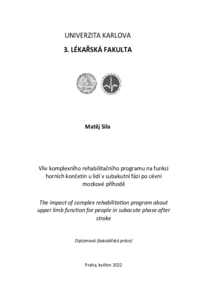Vliv komplexního rehabilitačního programu na funkci horních končetin u lidí v subakutní fázi po cévní mozkové příhodě
The impact of complex rehabilitation program about upper limb function for people in subacute phase after stroke
bachelor thesis (DEFENDED)

View/
Permanent link
http://hdl.handle.net/20.500.11956/180166Identifiers
Study Information System: 244432
Collections
- Kvalifikační práce [3219]
Author
Advisor
Referee
Hlinovská, Jana
Faculty / Institute
Third Faculty of Medicine
Discipline
Physiotherapy
Department
Department of Rehabilitation Medicine 3FM CU and UHKV
Date of defense
24. 6. 2022
Publisher
Univerzita Karlova, 3. lékařská fakultaLanguage
Czech
Grade
Excellent
V této bakalářské práci je ověřován vliv třítýdenního rehabilitačního programu u pacientů v subakutní fázi po cévní mozkové příhodě za účelem zlepšení funkce horní končetiny a kvality života. Výsledný soubor se skládá ze 32 jedinců hospitalizovaných na oddělení následné rehabilitace Kliniky revmatologie a rehabilitace 3. lékařské fakulty Univerzity Karlovy a Fakultní Thomayerovy nemocnice. Pohlaví byla ve vyváženém zastoupení v poměru 18 mužů a 14 žen. Průměrný věk představuje u pacientů 78,13 let. Hodnocení pacientů probíhalo na základě výsledků klinických testů. Pacienti byli hodnocení před a po třítýdenním rehabilitačním programem. Pro hodnocení celkového stavu pacientů po cévní mozkové příhodě byly vybrány testy National Institute of Health Stroke Scale a modifikovaná Rankinova škála. Hodnocení motorických funkcí horní končetiny bylo posuzováno na základě výsledků z Nine Hole Peg Testu, Action Research Arm Testu, měření svalové síly pomocí dynamometru a měření posturálního třesu Akcelerometrem, omezení funkce horní končetiny v ěběžném životě pomocí Motor Activity Log. Pro hodnocení kvality života byl zvolen dotazník Item Short From Survey Instrument. Hodnocení celkového stavu přineslo signifikantní rozdíl u obou testů. U National Institute of Health Stroke Scale došlo ke zlepšení v průměru o...
This bachelor's thesis verifies the impact of a three-week complex rehabilitation program about upper limb function and quality of life in patients in the subacute phase after a stroke. The resulting set consists of 32 patients hospitalized in the department of subsequent rehabilitation of the Clinic of Rheumatology and Rehabilitation of the 3rd Faculty of Medicine of Charles University and the University Thomayer Hospital. Gender was balanced at a ratio of 18 men and 14 women. The average age represents 78.13 years for patients. The evaluation of patients was based on the results of clinical trials. Patients were evaluated before and after a three-week rehabilitation program. National Institute of Health Stroke Scale tests and a modified Rankin scale were selected to evaluate the overall condition of stroke patients. Evaluation of upper limb motor function was assessed on the basis of results from the Nine Hole Peg Test, Action Research Arm Test, measurement of muscle strength with dynamometer and postural tremor accelerometer, limitation of upper limb function in everyday life with Motor Activity Log. The Item Short From Survey Instrument was chosen to evaluate quality of life. The assessment of the general condition produced a significant difference for both tests. The National Institute of...
